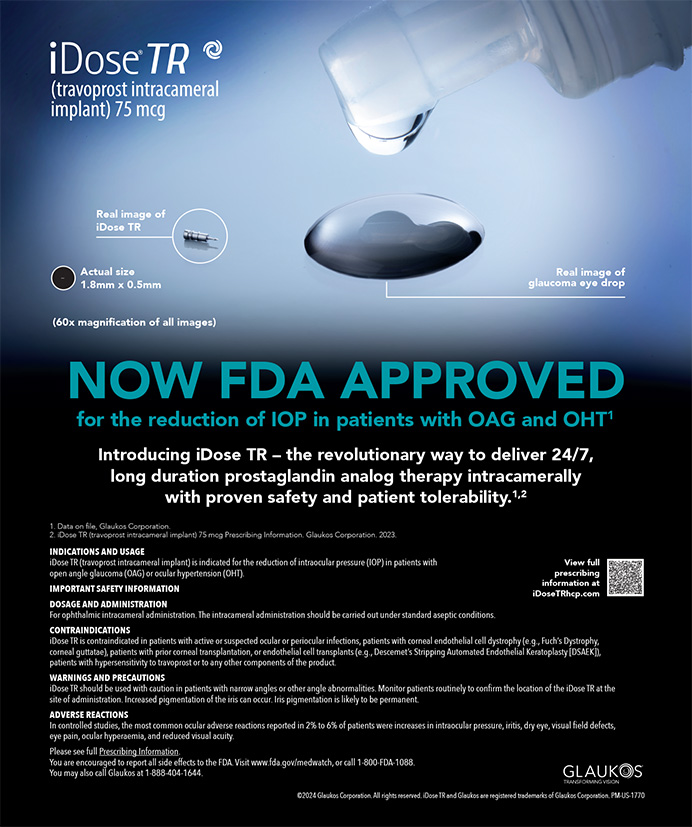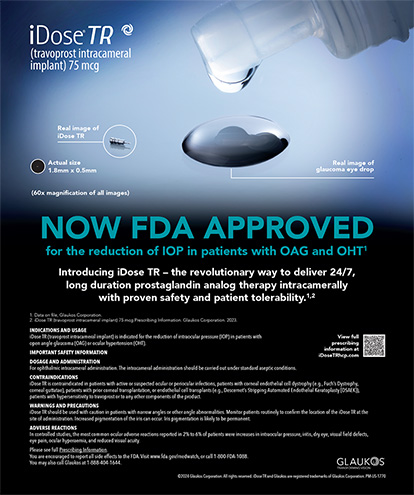A 26-year-old white woman who is interested in vision correction presents to your clinic for a consultation. She wears soft contact lenses but has become intolerant of them, especially in her right eye. Her past medical/ocular history is significant for varicella at age 5, followed by keratitis at age 8. The patient vaguely recalls being on multiple eye drops at that time and some concern that she would have "permanent damage."
On examination, her BCVA is 20/20 OU with manifest and cycloplegic refractions of -3.00 +0.50 X 100 OD and -2.25 D sphere OS. Her pupils measure 6 mm (mesopic), and central ultrasonic pachymetry readings are 585 μm OD and 595 μm OS. A slit-lamp examination of the patient's right eye reveals a clear central cornea but moderate neovascularization superiorly with scattered nummular scars (Figure 1). There is no evidence of active inflammation. The examination of her left eye is normal (Figures 2 and 3).
How would you proceed? Would you offer PRK, LASIK, a phakic IOL, or nothing? Is there a risk of reactivating the viral keratitis? Would prophylaxis with antivirals be of help?
—Case prepared by Parag Majmudar, MD.
GREGG J. BERDY, MD
We ophthalmologists routinely encounter this scenario: a patient presents to our office with a clinical sign, and we attempt to establish a list of differential diagnoses that could explain the finding. In order to formulate a working diagnosis, we acquire historical data, inquire about subjective symptoms, and look for objective clinical findings. In this case, the patient had varicella as a child and an episode of keratitis in her right eye several years later. She also successfully wore soft contact lenses in the past but has become intolerant in her right eye. Figure 1 demonstrates superior corneal neovascularization and peripheral scarring, and the lid margin exhibits hyperemia and plugging of the meibomian gland.
Additional clinical information that would help in planning treatment would be the status of the tear film. Specifically, I would perform a Schirmer test and assess tear osmolarity for information on the aqueous layer and evaluate the meibomian gland's secretions to learn more about the lipid layer and corneal sensation.
A differential diagnosis for the corneal findings would include limbal stem cell deficiency, varicella zoster virus scarring, herpes simplex virus (HSV) scarring, Staphylococcus marginal infiltrates, and phlyctenulosis.
Prior to offering refractive surgery as an option to this patient, it would be wise to treat the ocular surface disease and the underlying conditions of meibomian gland dysfunction and dry eye disease (DED) as well as to have her discontinue wearing contact lenses. I would prescribe treatment with a topical steroid (loteprednol etabonate ophthalmic ointment 0.5% [Lotemax; Bausch + Lomb]), cyclosporine ophthalmic emulsion 0.05% (Restasis; Allergan, Inc.), azithromycin (AzaSite; Merck & Co., Inc.), oral omega-3 supplementation, and hot compresses. Once the ocular surface normalized, the patient's corneal sensation could be tested. If intact, the corneal scarring might not be due to HSV.
It is worth noting that the American Academy of Ophthalmology's Refractive Errors & Refractive Surgery Preferred Practice Pattern guidelines list uncontrolled external disease (eg, blepharitis, DED, atopy/allergy) as a contraindication to refractive surgery and a history of HSV or varicella zoster virus as well as inadequately controlled DED as relative contraindications.
Given this patient's clinical history and the planned treatment described earlier, if her corneal sensation were intact and the ocular surface normalized with regression of the corneal neovascularization, I would offer LASIK surgery after proper informed consent. The peripheral nummular corneal scarring may be secondary to staphylococcal marginal disease, but in case it is due to herpetic disease, I would prophylactically treat the patient with an antiviral oral agent.
SHACHAR TAUBER, MD
This patient has a childhood history of varicella keratitis and is requesting the surgical correction of her straightforward refractive error due to contact lens intolerance. Aside from mild corneal neovascularization and irregular astigmatism consistent with peripheral scarring, there does not appear to be a contraindication to refractive surgery. Although many surgeons would reflexively defer corneal refractive surgery, others have reported success with both PRK and LASIK in similar patients using oral antivirals (acyclovir 400 mg b.i.d. for 1 week preoperatively and continued for 1 month postoperatively).1,2
On expertmapper.com, there are more than 250 articles dating back to 1999 regarding the complications of herpes zoster ophthalmicus. A thoughtful discussion with the patient regarding the ophthalmic issues that might arise if excimer laser ablation reactivated the herpes zoster keratitis would be necessary. She should also be offered the option of a phakic IOL, which would not reactivate a dormant viral keratitis. Prior to any ocular surgery, preexisting ocular inflammation, increased IOP, lagophthalmos, DED, exposure, or neurotrophic keratitis would have to be managed appropriately.3
Finally, the surgeon would do well to counsel the patient to reevaluate her contact lens intolerance after the aggressive treatment of any ocular surface disease and after receiving the advice of an expert on the newest soft, gas permeable, corneal and scleral contact lenses. Her left eye could undergo either LASIK or PRK.
GEORGE O. WARING IV, MD
The patient's clinical examination is remarkable for mild myopia, minimal refractive astigmatism, and a BCVA of 20/20 OU. The slit-lamp examination reveals superior “nummular” scars and corneal neovascularization in the patient's right eye, although the depth is not specified. Placido topography demonstrates irregular astigmatism with inferior steepening in the right eye. Scheimpflug tomography demonstrates normal pachymetry and anterior and posterior float maps bilaterally. Further history would include any prior episodes of herpetic outbreaks, including labialis. Additional testing would include corneal anesthesiometry to evaluate the patient for decreased corneal sensation.
A definite link between preexisting herpes reactivation and laser refractive surgery has not been demonstrated. Although several reports of herpetic keratitis after laser refractive surgery have been published, plenty of cases have been performed routinely without sequlae with appropriate prophylaxis.1,4-7 It seems that this patient's keratitis is just as likely from simplex as it was from zoster, given her young age at onset and the time interval between her initial episode of systemic zoster and keratitis.
The irregular astigmatism with inferior steepening may have resulted from the corneal scarring. Based on the information provided, I would monitor the patient with serial exams over a period of 6 to 12 months and consider implanting a phakic IOL, an approach that is being used routinely in Asia and Europe to correct low degrees of myopia. If the patient's manifest refraction and topographies remained stable over time, and if she maintained normal and equal corneal sensation and did not experience a herpetic outbreak for more than a year, I would consider LASIK in the future with oral prophylaxis and an additional informed consent.
Section Editor Stephen Coleman, MD, is the director of Coleman Vision in Albuquerque, New Mexico.
Section Editor Parag A. Majmudar, MD, is an associate professor, Cornea Service, Rush University Medical Center, Chicago Cornea Consultants, Ltd. Dr. Majmudar may be reached at (847) 882-5900; pamajmudar@chicagocornea.com.
Section Editor Karl G. Stonecipher, MD, is the director of refractive surgery at TLC in Greensboro, North Carolina.
Gregg J. Berdy, MD, is in practice with Ophthalmology Associates and is an assistant professor of clinical ophthalmology in the Department of Ophthalmology and Visual Science at Washington University School of Medicine, both in St. Louis. He acknowledged no financial interest in the products or companies he mentioned. Dr. Berdy may be reached at gregg.berdy@youreyedoc.com.
Shachar Tauber, MD, is the section chair of ophthalmology and the director of ophthalmic research and telemedicine at Mercy Eye Specialists in Springfield, Missouri. Dr. Tauber may be reached at (417) 820-9393; shachar.tauber@ mercy.net.
George O. Waring IV, MD, is the director of refractive surgery for the Storm Eye Institute and an assistant professor of ophthalmology at the Medical University of South Carolina in Charleston, South Carolina. Dr. Waring is also the medical director of Magill Vision Center in Mt. Pleasant, South Carolina. Dr. Waring may be reached at waring@musc.edu.
- de Rojas Silva V, Rodríguez-Conde R, Cobo-Soriano R, et al. Laser in situ keratomileusis in patients with a history of ocular herpes. J Cataract Refract Surg. 2007;33(11):1855-1859.
- Kaufman SC. Use of photorefractive keratectomy in a patient with a corneal scar secondary to herpes zoster ophthalmicus. Ophthalmology. 2008;115(2 suppl):S33-S34.
- Kaufman SC. Anterior segment complications of herpes zoster ophthalmicus. Ophthalmology. 2008;115(2 suppl):S24-S32.
- Davidorf JM. Herpes simplex keratitis after LASIK [letter]. J Refract Surg. 1998;14:667.
- Perry HD, Doshi SJ, Donnenfeld ED, et al. Herpes simplex reactivation following laser in situ keratomileusis and subsequent corneal perforation. CLAO J. 2002;28:69-71.
- Gomez Garcia S, Pinero Bustamonte AM, Gutierrez Sanchez E, et al. Herpes simplex keratitis following laser in situ keratomileusis [in Spanish]. Arch Soc Esp Oftalmol. 2004;79:139-142.
- Levy J, Lapid-Gortzak R, Klemperer Itamar, et al. Herpes simplex virus keratitis after laser in situ keratomileusis. J Refract Surg. 2006;22:509-511.


